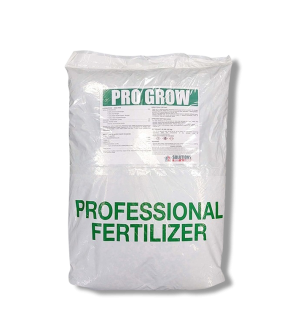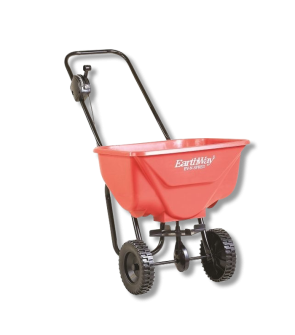Gain access to personalized product screening, the best pricing, rewards, and more!
Most Effective Products
How To Calibrate Your Fertilizer Spreader
When you are fertilizing your lawn with a granular fertilizer, it's crucial that you get a nice even spread so that your lawns soil receives the same amount of nutrients across the entire yard. If you apply too little, you won't achieve the desired results. Apply too much and you risk harming your turf on top of wasting money and material.
In order to uniformly apply fertilizer to your lawn, its important that your spreader is properly calibrated for the job. There are a number of different types of fertilizer spreaders you can use a handheld spreaders, push broadcast spreaders or drop spreaders. Depending on the method you choose, the fertilizer you're using, and the spreader model, the way you calibrate the spreader can vary.
On the manufacturer label of the fertilizer you purchase, there are often calibration settings for various spreader types but these are merely a suggested starting point and may not be totally accurate to your spreader depending on your spreader age and wear. What can also happen is that the calibration settings for your spreader model may not be listed on the label.
While it may appear complicated, calibrating your spreader can be easy if you do a little bit of math and have the right measurement tools in place. In this guide we will explain how you can calibrate your spreader by carrying out the following easy tasks:
- Measure out the proper amount of fertilizer for your lawn
- Loading your spreader with fertilizer
- Measure the swath width of your spreader
- Performing a test run with your spreader and adjusting the spreader settings accordingly
Tools needed

To calibrate your spreader you will need: a broadcast spreader, the fertilizer you purchased, a bucket to weigh your fertilizer, a scale, a push broom, a measuring instrument (tape measure or measuring wheel), landscape paint or marking flags to mark off a test area, and a calculator.
You will also need a paved area to perform test runs to measure your fertilizer spreaders broadcast swath. Testing on a solid surface rather than on your turf allows you to better see how the granules fall when they exit your spreader. makes for an easier clean up, and spares your turf from being burned or damaged by testing fertilizer on it.
How to Calibrate Your Spreader
Step 1: Measure Out The Proper Amount of Fertilizer

Determine how much fertilizer you need to cover a 1,000 sq. ft. test area. The instructions of the fertilizer label should have a suggested rate provided.
For example, on the label for Solutions Pro Grow Summer Blend fertilizer, 5 lbs of fertilizer can cover 1000 sq. ft. of space. Pour out the fertilizer and weigh it on a scale until you get 5 lbs then set it aside.
Step 2: Measure Out A Test Area

Measure out and mark off a paved area on your property with the help of your measuring instrument. Measure and multiply the area length times the width in feet until the square footage is 1,000 sq. ft. and mark off this area with the help of a marking tool like washable paint or objects, like safety cones, to mark border outline.
Treatment areas with irregular shapes, would make it easier to measure and treat when divided into smaller sections for area calculations.
Step 3: Measure the Swath Width of Your Spreader
The swath is the area of coverage by your spreader when operating. Since the spreader operates via movement of the wheels, the speed of your walk affects the spread of your fertilizer granules. For all types of spreaders, you will want to walk a reasonable speed of roughly 3 miles per hour.
If you have a faster walking space, you will have a much wider swath than someone with a slower walking pace. No matter your pace, its important to walk at that even pace for the duration of your spreading (don't start slow then go fast then go back to slow). If you have an uneven pace of walk, you could run out of product before application is complete. As a result, you will refill and have an uneven spread application.
On your chosen area of test ground, add enough fertilizer into the spreader hopper to walk a short distance of about 20 to 30 feet and measure the swath spread. Set the spreader setting to the middle setting and then start spreading at your normal walking speed.
Once you have finished, measure the width of the swath. This is the area between two points where the fertilizer granules begin to thin out. Make a note of your findings.
Divide the swath width you just measured by 1,000 to give you the length needed to cover the 1,000 sq. ft. test area marked off in step 2. For example, if you measured a 10 foot swath, dividing it be 1,000 means you will need to make a 100 foot run to cover 1,000 square feet with your fertilizer granules.
Step 4: Load the Spreader and Adjust Settings Following a Test Run
Add the 5 lbs of fertilizer that you measured out in step 1 to the spreader hopper. With your spreader still on the middle setting, start walking along at the starting point of your 1,000 sq. ft. test area and walk at an even pace until you reach the end. If you run out of material before reaching the end, you need to decrease the setting.
If product remains in the spreader after you have covered the 1,000 sq. ft test area, you will need to increase the setting. Decreasing the setting to a lower number closes the spreader opening more which allows less fertilizer material to be released, while increasing the setting to a higher number opens up the spreader opening more, allowing more fertilizer material to be released.
An alternative way to adjust the spreader settings is to weigh the remainder of the fertilizer in the spreader hopper after a test run. If the goal is to apply 5 lbs of fertilizer material per 1,000 sq. ft and you weighed the remaining fertilizer in the spreader to be 2 lbs, that means you applied too little fertilizer to the test area and need to dial up your spreader setting.
Refill your spreader and adjust the settings until your spreader is broadcasting the correct amount of fertilizer that the label recommends per 1,000 sq. ft.
Things To Consider
- When calibrating your spreader, make sure you test with the actual fertilizer you will be using to get a more accurate reading.
- You may have to do multiple test runs with the fertilizer until you achieve the desired spread rate for even coverage. It shouldn't take more than 1 or 2 additional runs after the initial test to get the spreader calibrated to the fertilizers recommended application rate.
- Make sure you sweep up the material on the hard surface so you don't waste fertilizer and so the product doesn't run-off where it shouldn't or stain your surface.
Key Takeaways
- Calibrating your spreader is an important preliminary task before applying fertilizer to your lawn so your fertilizer is spread properly and evenly at the right amount.
- While fertilizer labels often give spreader settings to calibrate your spreader, these are usually just starting points and you would have to adjust the spreader to get the proper distribution.
- To calibrate your spreader you will need: a broadcast spreader, the fertilizer you purchased, a bucket to weigh your fertilizer, a weight scale, a broom, a measuring instrument (tape measure or measuring wheel), landscape paint or marking flags to mark off a paved test area, and a calculator.
- Measure out the proper amount of fertilizer according to the manufacturer labels recommendation and then measure out a test area on a paved surface so you can better see the granules.
- Measure your spreader's swath width and perform a test run on a 1,000 sq ft area, adjusting the spreader settings higher or lower depending on how much fertilizer is spread during the run until you get an accurate distribution that is in sync with the labels recommended rate.











